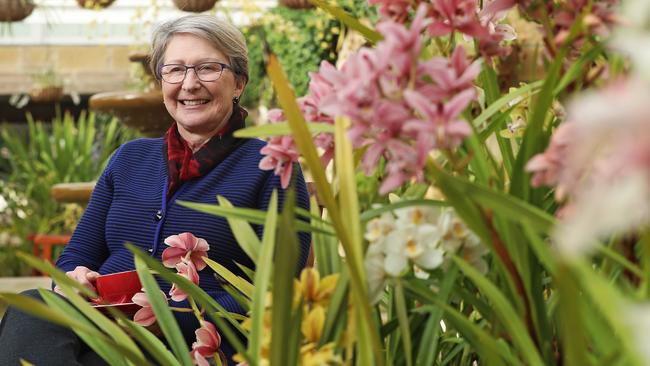Royal Tasmanian Botanical Gardens chief discusses booming tourist numbers
ROYAL Tasmanian Botanical Gardens board chair Beth Mathison knows a thing or two about managing increased tourist numbers.

Tasmania
Don't miss out on the headlines from Tasmania. Followed categories will be added to My News.
AS environmentalists fret over surging visitation to our most popular national parks, a former tourism dynamo who once ran a bear park is leading a group that faces similar concerns much closer to home.
MORE: HUGE VISITOR NUMBERS THREATEN NICHE APPEAL
MORE: GROWING PASSION FOR OUR PARKS SPARKS WARNING
As board chair of the Royal Tasmanian Botanical Gardens, Beth Mathison keeps a close eye on the delicate balance between preserving the gardens for local people and catering for surging tourism numbers from interstate and overseas.
While national park concerns centre on risks posed to fragile environments, both Parks and the gardens face the challenge of providing more infrastructure to meet growing needs while impacting minimally on landscapes.
Statistics released this week show rising visitation to protected sites such as Freycinet National Park, which attracted 310,000 over 2017-18. The botanical gardens in Hobart coped with 476,000 visits over the same period.
Australia’s second-oldest botanical garden celebrates its 200th birthday this year without enough toilets or food to service its 22 per cent increase in guests over the past five years, a trajectory expected to continue into the foreseeable future.
And, until recently, it had no money to address the shortages.
It’s a splendid morning at the gardens when I meet Mathison at Succulent restaurant, where the view takes in a grand sweep of the 14ha site stretching from almost Macquarie Point to New Town.
Mathison is on time, unlike on April 10, when she accidentally made Prince Edward wait a few minutes at the front gates on his Royal Highness’s visit to open an addition to the gardens’ Lily Ponds commissioned for the bicentenary.
We’re here to talk about ways to sustain one of Hobart’s best-loved places well into the future, and how to finance that vision.
But first I want to know more about Mathison’s curious era in Scotland, which comes up even before our leaf tea arrives. Bears? You mean live bears? Yes, says the former Queenslander with a laugh, raising her hands alongside her face like claws: “Himalayan bears, brown bears, black bears, you name it.”
The bear park was part of historic Cameron House on Loch Lomond near Glasgow. Mathison owned and ran the estate for four years in the 1980s, receiving up to 150,000 visitors annually after leading the restoration of its eight hectare botanical gardens (the bears lived in an adjoining 32 hectare park).
“It was beautiful prime land, like this,” she says, “and the house we lived in was like the Governor’s house. It even had a beautiful high wall like the one surrounding this garden.”
Before the bear park, Mathison undertook her first horticultural challenge, in Devon, UK, buying former monastery Higher Leigh Manor and tackling a major blackberry infestation to reveal an expansive sub-tropical botanical garden planted in the 1920s.
MORE
KIM SEAGRAM: FERMENTING THE FUTURE
DAVID BARLETT: HOOPS DREAM CAN MAKE CITY GREAT
ANDREW SMITH: MANAGE VISITOR NUMBERS CAREFULLY
POLLY MCGEE: WE NEED A BOLD START-UP CULTURE
KATE WARNER: FIX TASMANIA’S SCHOOLING SYSTEM
LEIGH CARMICHAEL: DIM THE LIGHTS AND LET’S PARTY
MATHISON moved to Tasmania 14 years ago to be closer to her first grandchild and works mostly as a business consultant. She joined the gardens’ board nearly three years ago, taking the chair last November.
She says one thing that makes raising revenue tricky is that under the relevant Act, the gardens cannot charge an entry fee. Clearly, such a toll would not go down well with locals, but it’s hard for Mathison not to occasionally fantasise about the rivers of gold that could flow from charging, say, cruise ship passengers and their ilk.
Given that’s not going to happen, an alternative plan has been hatched and is under way thanks to a one-off $3.6 million drop from the State Government this year. This amount is in addition to the annual $2.6 million the gardens receives to pay staff.
The plan, already well-advanced, is to funnel guests through a purpose-built entrance building, where they will be able to make donations, purchase merchandise, enjoy exhibitions, learn more about the gardens, and, in good news for green thumbs, buy plants propagated on site, including at a Sunday market.
Office facilities beneath the current shop and restaurant will move to the new building, freeing up the existing space to expand the food offerings and functions potential. Crucially, there are additional toilets in the plan. The build is slated to begin mid-2019.
Revenue will be poured back into projects, including developing a temperate rainforest area, new specimen trees (especially important after the loss of some mighty ones in May), the maintenance of the invaluable seed bank and more.
For now, the countdown is on for the annual tomato sale, on October 18 and 20. In keeping with the gardens’ charter, it is about putting the local community first. Last year the sale raised $35,000.
As for proposed merchandise in the new shop, I find myself hoping there will be none of those ubiquitous Tassie devil soft toys. As for lavender bears? Who knows, if Mathison has a say.


